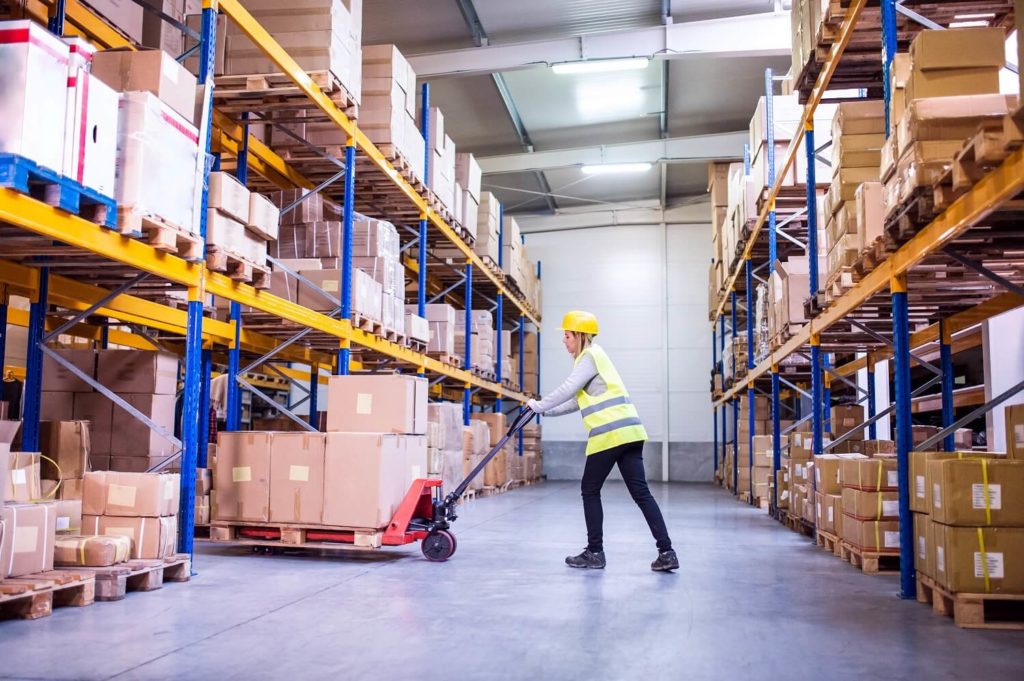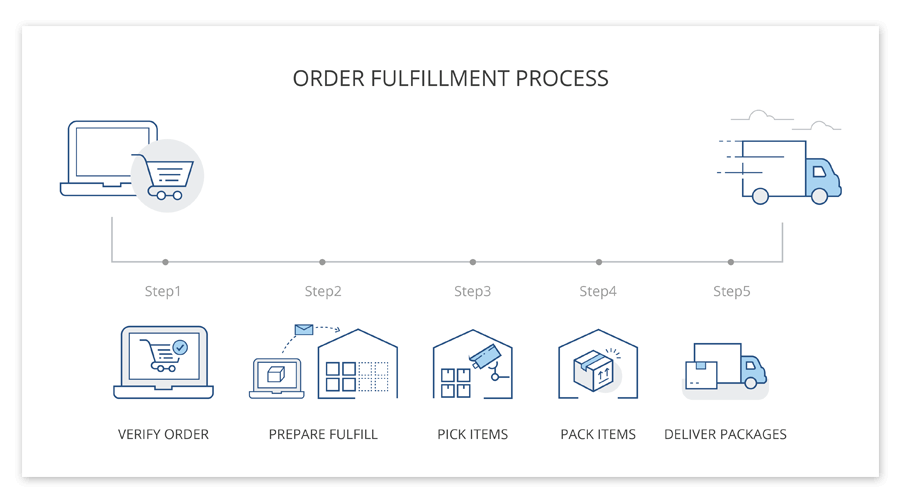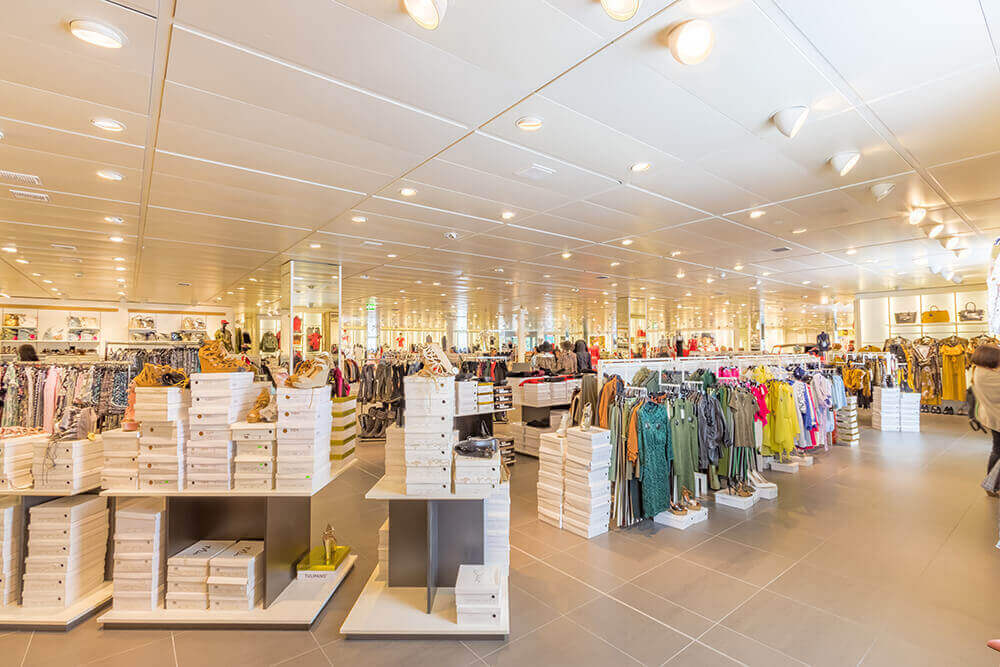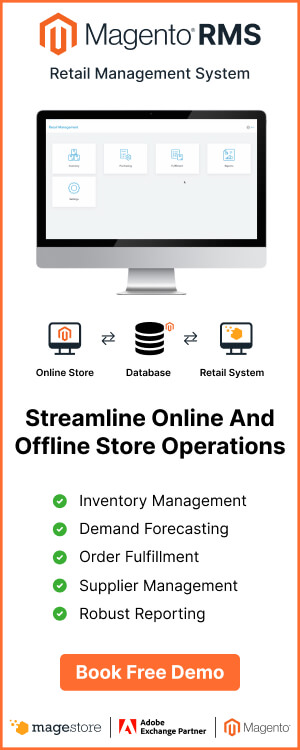This 2023 may continue to be considered as the throne of the omnichannel trend and it has had a remarkable effect on fulfillment operations. In other words, omnichannel fulfillment is more and more becoming an indispensable solution for retailers who want to stay competitive today.
What is omnichannel fulfillment?
Definition
The fulfillment service is growing and gradually turning popular thanks to the explosive development of eCommerce. As a result, most commercial transactions are “internalized”, and sales are quicker and simpler, resulting in an increase in the number of orders. Typically, Amazon handles an average of 35 orders each second. Thus, omnichannel fulfillment has become an essential part of businesses to resolve these difficulties.
If so, what is the exact definition of omnichannel order fulfillment?

Omnichannel fulfillment (or omnichannel order fulfillment) can simply be understood as the whole process from the time the customer orders to the time the merchandise is delivered to the end-user. It includes pick up, warehousing, packaging, and delivery to the buyer on time, etc… through a synchronous way, where the data channels are centralized together.
Omnichannel retail fulfillment also allows customers to research products, compare prices, make purchases and receive goods via multiple channels, and move between channels seamlessly.
With the right omnichannel fulfillment model, retailers can simplify and automate order fulfillment while achieving the speed and agility needed to compete in a rapidly changing retail industry.
Process
Omnichannel order fulfillment comprises 5 basic processes:
- Warehouse organization: Check the merchandise, warehousing, inventory management;
- Order management: Order processing, order confirmation;
- Packaging: Pick the products, print labels, packaging;
- Shipping / Return: Delivery, shipping, payment / refund, return goods;
- Customer communication: Contact, customer care after sales.
Why need an omnichannel fulfillment?
According to a preview of a research report from BI Intelligence, Business Insider’s premium research service:
“Brick-and-mortar retailers are caught on the wrong side of the digital shift in retail, with many stuck in a dangerous cycle of falling foot traffic, declining comparable-store sales, and increasing store closures.”
And more than 8,600 retail stores could close this year in the US — more than the previous two years combined, brokerage firm Credit Suisse said in a recent report.
Meanwhile, eCommerce pure-plays are riding the rise of digital commerce to success — none more so than Amazon, which accounted for 53% of online sales growth in the US last year, according to Slice Intelligence.
In response, a large number of brick-and-mortar retailers have started to use omnichannel order fulfillment strategies that rocket their store locations and in-store inventory in order to better compete in eCommerce.
Moreover, in another perspective, running a retailer business means that you have to deal with hundreds of orders (high volume of sales orders) every day and messy shipments.
Satisfying the demands of customers and optimizing this trend-based business requires a quick and timely response as well as a consistent shopping experience. Hence, omnichannel order fulfillment is born as a necessity with many outstanding advantages, promising to be an indispensable factor in many business activities.
Benefits of omnichannel fulfillment

Manage and reduce inventory costs
Founding on a Peoplevox report (2016), 82% of eCommerce businesses realize increased sales, indicating that eCommerce has opened up great business potential. This also means the number of orders will increase, businesses have to put more goods in the warehouse, increase the number of employees to manage the items, and ensure products are delivered to consumers on time.
However, the confusion begins when the business has to balance between marketing and sales activities while managing inventory as well.
The omnichannel order fulfillment’s role in this regard is the synchronization of data, which handles orders quickly from A-Z. As a result, the company saves about half of the cost of warehousing, staffing and spends more time focusing on business.
Equitable seller benefits and buyer satisfaction
Proper quantity and timely delivery are important in online sales because it affects the satisfaction of the buyer. According to a recent study, 48% of customers refuse to continue shopping on eCommerce sites that have been slow in delivery. However, in reality, 63% of businesses admit that they don’t deliver on time due to many objective factors.
Consequently, omnichannel order fulfillment as a solution ensures customer satisfaction in this case. The order fulfillment model arranges and manages orders professionally for delivery on time and in the right quantity to the buyer, and collects the seller’s money if required (COD – Cash on delivery). Thus, the seller can sell goods, and gain profits without losing processing time and delivery while buyers are satisfied when receiving products on time.
And much more…
These omnichannel technologies can help retailers manage the operation smoothly by:
- Accurate Inventory Management – Effectively managing warehouse and inventory helps keep cross-channel fulfillment consistent.
- Real-Time Reporting – If you implement an omnichannel fulfillment model, monitoring warehouse and fulfillment center performance is key. In-depth and granular insights reveal essential performance metrics. With real-time reporting, you’ll be able to constantly adapt and improve warehouse processes.
- Sales and Revenue – Distributing products through several channels opens up new market opportunities, resulting in increased sales and revenue.
- Warehouse Productivity – Implementing a system that takes advantage of new technology to streamline fulfillment processes provides warehouse personnel with more detailed information in areas such as inventory, increasing overall operational efficiency.
- Customer Satisfaction and Retention – Retail fulfillment processes that leverage multi-channel distribution open up different buying channels. As a result, those customers are likely to be more satisfied with your brand and will keep coming back for more.
- Brand Perception – Brands that take advantage of multiple distribution channels are viewed in the marketplace as attentive to customers’ needs and preferences. This differentiates your brand from competitors who have yet to take advantage of multi-channel distribution.
In addition, Magestore is also offering a Magento order fulfillment management feature, which can help retailers overcome the troubles. This is the perfect solution for your retail problem, which allows you to create new orders, manage all orders and track the order fulfillment process in only 5 simple steps.

Streamline 5 standard steps for the fastest processing “Verify – Fulfill – Pick – Pack – Deliver“
- Verify order (optional): sales staff can confirm and edit the customer’s shipping and billing address
- Prepare fulfillment: separate orders into 2 groups whether all ordered items are available in stock or not;
- Pick items: able to select multiple orders to print out into a composite picking list
- Pack items: able to create multiple packages for an order
- Deliver packages: displays shipping information and tracking number provided by the carrier
- Inline order, editing, and touchscreen support allow staff to save time working on each step of order processing
- Multi-warehouse fulfillment made it easy and correctly
- API integration with all Magento-supported shipping carriers
Omnichannel flow path
Head of Proprietary Research and Acting CFO at L2 said that: “Retailers are having to subsidize free shipping in order to compete. Now, the speed of fulfillment is the next area of competition. As retailers have fought back against Amazon with omnichannel delivery and return options that leverage their store locations as a competitive advantage, consumer expectations are increasing in this regard as well. Retailers are having to increase their investments in inventory visibility and fulfillment capabilities.”
Therefore, a number of business retailers leverage their delivery and fulfillment strategies by offering:
Buy online, pickup in store (also called click and collect)
A cost-saving order fulfillment option for retailers to bring the online and brick-and-mortar channels together in a single integrated approach, helping customers get their purchased goods – fast! Get rid of the line altogether. See more.
Buy online, dropshipping
A cost-effective order fulfillment model helps retailers eliminate fulfillment and inventory issues, and utilize a drop-ship vendor to process the eCommerce order for customers more efficiently and faster. See more.
In-store purchase, home delivery
No matter if an end customer decides to buy online or directly at a store, our tried and trusted direct delivery function enables them to conveniently have everything delivered right to their home. See more.
Ship from store
Connect your brick and mortar stores & eCommerce channels by exposing store inventory online and turning your retail outlets into mini-fulfillment centers to seamlessly fulfill the eCommerce orders to customers.
Buy online, return in store
Same day/on-demand delivery
All the methods are used to bring a great and seamless shopping experience to the customers. Omnichannel fulfillment takes the ultimate goals to manage the order process effectively as well as satisfies the consumer. Consequently, the following path above is to make the convenience of the purchase process.
Omnichannel fulfillment challenges
Challenge 1: Lack of inventory visibility

The vital of an omnichannel approach is to know the status of your inventory.
The last thing retailers want is to promise next-day delivery to the customers and not be able to follow through. This can be a difficult need solving especially during holiday shopping seasons. Developing an efficient omnichannel order fulfillment process that works via an optimized warehouse management system is the requirement. By using inventory visibility as a precise forecaster of future demand, you can plan your supply chain activities effectively.
Retailers that put omnichannel into application the right way – setting up a measure for inventory visibility – their store will be more able to prove a smooth customer shopping experience while staying on top of their supply chain.
Challenge 2: Channel-specific processes
The next challenge for businesses is focusing on channels independently.
If a retailer’s various supply chain processes are not firing on the same cylinder, then how can they ensure entirely customer satisfaction? The answer is they can’t.
Your supply chain needs to be integrated across your own store, retailers, and other online sales channels. Synchronization of sales channels will help the order fulfillment processes faster.
Besides, implementing omnichannel will also enable you to use spaces variably. Warehouses can act as showrooms. Ikea, for example, uses this model for a highly cost-efficient supply chain.
Challenge 3: Speed of delivery
Referring to selling across channels nowadays in the retail market, the speed of delivery plays an important role. But this is one of the hardest parts to ensure the merchandise is delivered to the end-user on time. When a customer buys online, they expect that order to come within a few days as soon as possible.
If a retail company has an unreliable order fulfillment process, it can lead to delays in shipping, which can, in turn, prevent a customer from wanting to do business with that retail company ever again.
A good way to ensure a streamlined order fulfillment process is to employ the proper technology to help forecast future delays in service or shipping.
Moreover, in order to meet the rising desire among customers, retailers should serve as both pickup locations for online orders — buy online, pick up in-store or click and collect — and fulfillment locations for deliveries (ship-from-store).

U.S. click and collect sales, 2019-2024, from eMarketer
Allowing customers to buy online and pick up in store saves both the customer and the company money and time. Also, they may make additional purchases when picking up an order.
To sum up, most retail stores are not set up to fulfill orders and most lack good inventory visibility. Their backroom space is limited, and store employees are trained to sell, not fulfill orders. Those all lead to an impact on the speed of delivery that will not satisfy the customers
Challenge 4: Ease of return
Handling the return of orders should be a crucial consideration when setting up your omnichannel logistics system. If a customer purchases one of your products online, can they return it simply by visiting the closest retail store or dropping it back into the mail? Then the chances of that customer coming back for more purchases are narrow to none.
Implementing sound reverse logistics infrastructure is crucial to good customer service within omnichannel tactics.
Omnichannel logistics is all about providing consumers with the most seamless shopping experience. But this is only achieved when a retailer can leverage their eCommerce capabilities with the realities of running a brick-and-mortar store and distribution center network.
Though these challenges are big, your return on investment will greatly outweigh these initial problems.
To simplify the fulfillment process, you need either a reliable system or a trusted fulfillment partner. We’ve curated the list of 9 top fulfillment solutions for eCommerce for your convenience. Let’s take a look to find the optimal option.
Omnichannel fulfillment strategy
As the key strategies for success in the omnichannel order fulfillment market, these strategies serve as a guide for business retailers to continue to grow in eCommerce.
Invest in omnichannel order fulfillment technology
There are many important technologies that are simply under-utilized, including TMS, DOM, and demand planning. These technologies permit companies to become more efficient in allocating inventory to stores, and warehouses in an efficient, reliable way as well as save costs to move merchandise from origin to destination. Then also, they capture all information in the order management fulfillment process across all channels.
Backing of eCommerce and omnichannel
The current omnichannel retail model shift resulted in large part from the development of eCommerce, which is the most significant supply chain management trend in the last decade. Brick and mortar retail sales have been relatively flat while eCommerce sales are growing at double-digit annual rates. The eCommerce trend is stimulating interest in technology to streamline and modernize order fulfillment.
Continuous Innovation

Innovation is pivotal for expanding the current sphere of omnichannel order fulfillment.
Companies need to continue to find new technologies and innovations for executing seamless fulfillment. Many companies are waiting to see how these companies pan out, but more emphasis needs to be placed on making bold moves with high reward potential. This indicates there are a lot of white spaces out there that can be filled by suppliers. This can be accomplished by new solutions or acquisitions – via logisticsviewpoints
Target high-growth markets
The omnichannel order fulfillment market is forecast to grow at an impressive pace, reaching over $3.7 billion by the year 2020.
To help foster this growth, retailers need to target high-growth markets. From a high-growth market perspective, companies are recommended to look at the Tier 2 market. While the majority of the largest players are actively targeting the Tier 1 market, there are more and more small companies penetrating the omnichannel world. This second tier of customers will continue to claim its share of the market and provide an excellent area of growth for suppliers.
In conclusion for this part, business retailers who want to stand in line with competitors need to set and follow the roadmap for success, or they will risk being abandoned behind. This strategy supports the changing nature of eCommerce and the omnichannel model. To reach the goals, they have to invest in technology, and create solutions that are more accessible, more powerful, and easier to use. Suppliers must also continue to innovate to meet the needs of their customers.
Case of success
Amazon has created one of the most advanced packaging and shipping networks in the world, so many sellers benefited from Amazon. With the Fulfillment by Amazon (FBA) service, your merchandise is stored at the packing center, Amazon will receive packaging, shipping, and customer service for the product. Even better, FBA helps you expand your business and reach out to more customers around the world.
According to the survey in 2014, 71% of respondents said that thanks to the FBA, their sales increased by more than 20% on Amazon.com since joining.
What is fulfillment by Amazon (FBA)?
FBA is a service that supports warehousing and shipping for merchants on Amazon.com. Amazon.com’s FBA can ship to Canada. This service helps your business grow rapidly with the strong purchasing power of the North American market. In addition, your merchandise will be more trustworthy when using Amazon’s FBA due to the quality inspection before shipping.
How does the FBA service work?

- Step 1: Ship to Amazon: Ship your goods to the Amazon FBA Center, new or used goods.
- Step 2: Amazon Inventory: Your product is listed and stored in the “Ready to ship” area.
- Step 3: Ordered Products: Customers order your product on your own website or on Amazon.com
- Step 4: Amazon pick and pack: FBA will pick up your product from the warehouse and pack it for you
- Step 5: Delivery and order care: Amazon will deliver to the customer from the FBA center. With direct orders from Amazon.com, customers enjoy customer service from Amazon
Here are the basics of selling on Amazon. Due to the specificity of the US market, there are many different rules and so much information that the seller needs to understand. Despite the difficulties, once you have shipped to Amazon, you have brought your goods to the world’s great sea.
Last but not least, to make all the processes operate smoothly, they must have a consistent data system among the channels, and a great and reliable order management fulfillment module. Hence, obviously, omnichannel fulfillment is a key to achieving the target.
















Dear Keenan,
Would you please give me permission to use your article’s figure of “Buy online, return in store- Same day/on-demand delivery”. I am planning to write a journal paper. Obviously it will also boost your work citation.
Thanks.